Countertop for the kitchen – quartz sinter, conglomerate or Corian?
Many customers ask us about the best solution for a kitchen worktop. Everyone has their own preferences, taste, style of use, and budget. So, below are some options for a kitchen worktop with their pros and cons:
Quartz sinter – recently very fashionable material, elegant, luxurious. What is sinter anyway? It is a mixture of quartz and natural materials that are pressed and fired at 1200C. Thanks to this, the sinters are resistant to high temperatures – we can safely put a hot pot on such a top, without fear that the top will be damaged. We can also cover the fireplace in the living room with a sinter. We can also cover the entire facade of the house with sinter, without fear that it will fade with time. The warranty on sinter for the effects of atmosphere is up to 25 years!
- Pros: Quartz sinter is resistant to high temperatures, it does not need to be impregnated like natural stone. It has no pores, so it is also dirt and stain resistant. Pleasant to the touch, it does not fade and due to its natural origin, it gives any kitchen a very noble look.
- Cons: it is a ceramic material and will therefore show some brittleness and susceptibility to mechanical impact. But you can easily cut with a knife on such a table without fear that it will scratch. It is also quite expensive material compared to other table top materials.
Corian – popular for the last two decades, it is slowly departing from the main trends in interiors. Why? Despite its beautiful appearance, corian is quite a soft material (the hardness scale is 4 – diamond is 10). It is made of resin and natural materials. The high resin content makes Corian very susceptible to scratching. However, it is a very grateful material for processing – you can combine forms into a uniform whole where you cannot see the joints; you can form sinks, you can mill drip trays, give curves, etc. Scratched corian can also be sanded – this procedure will restore its initial smoothness, but at the same time grinding is quite bothersome, especially in already used room.
- Pros: plasticity, elegant appearance, cheaper than sinter, a wide range of colors and patterns to choose from (smooth, imitations of stone, marble, etc.). Hygienic, often used on countertops in reception desks and doctor’s offices.
- Cons: susceptibility to scratches and stains (coffee, wine). Low temperature resistant. Use stands for pots.
CONGLOMERATE: a very popular material not only for countertops, but also for steps and window sills. Although it is also a mixture of resin and natural materials, its hardness degree is 3 degrees higher than that of Corian, amounting to 7. So it is a very hard material.
- Pros: a large range of patterns and colors to choose from, although most are shades of natural stone. The conglomerate can be processed in many ways – milled, satinised, rounded. It is resistant to mechanical impacts, shows high strength and stain resistance.
- Cons: some conglomerates (especially those with a matt surface) need to be impregnated. It is also quite heavy material and more expensive than Corian. Not resistant to high temperatures (due to the resin content) – so we have to keep hot pots on a stand.
The described materials are just a few examples of many solutions available on the market.
If you still have doubts about what to choose, contact us and we will surely advise you on the best countertop material for your kitchen!
written by Aleksandra Żurek,
Executive Director

